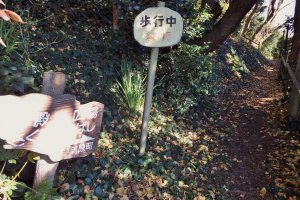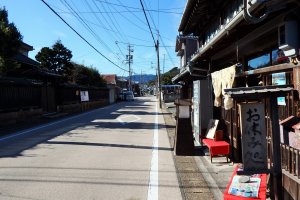The Tokaido, or 'Eastern Sea Road', was the most important route linking Tokugawa's new capital, Edo (now Tokyo), and the Imperial capital of Kyoto. Along the way, there were 53 designated juku, or post towns, that provided food and lodging for travelers. The 15th post town from Edo was Kanbara (or Kambara); and those with an interest in walking the ancient road should visit this section.
From Shin-Kambara Station, exit and walk toward the low mountains (away from the sea). Cross Route 396. Turn left and walk to the stream, and make a right. Then, walk to the next street - this is the Kyu-Tokaido, or old Tokaido Highway. From here, if you continue to walk straight, you'll come across a couple of small shrines surrounded by lovely cherry trees. Behind them is a trail that will take you to the top of tiny Mt. Gotemyama. It only takes about 10 minutes to what was once a noroshiba (an ancient spot used for signal fires).
However, if you turn left onto the Kyu-Tokaido, immediately on the corner is the Izumiya. Once a ryokan in former Kanbara-juku, this 180 year old building is now a quaint little 'rest stop' containing a shop and cafe. Although rather cluttered, the place is charming and some lovely ladies are working and/or weaving there. Choose from three 500 yen lunch choices - curry with rice, hashed beef and rice, or Chinese fried rice. You can also just sit on the tatami and have coffee, tea, or oshiruko - a traditional dessert made of pounded rice balls in a sweet bean paste soup.
The front room of the building has locally made crafts and food items for sale, and locals do traditional style weaving in the back. Some of their creations (ex. scarves) can be purchased. If you show an interest in the building, you will probably be offered a tour of the upstairs. It contains a nice tatami room with views of a majestic building across the street. This building was once a honjin, or special inn designated for feudal lords and high ranking officials.
If you continue down the street a short distance; on the right is a light green home with obvious Western and Japanese influences. The former Igarashi Dental Office, it is now open to the public as a museum with free admission. Sections of the home were built in the Meiji era, others were added in the Taisho and Showa eras. The home is decorated with very impressive fusuma (sliding doors) and unique wood carvings. It also contains a lovely garden and a couple of traditional kura storehouses.
A little farther down the street is the Shida-tei, a former merchant's home that was rebuilt around 1855. It can be toured for 300 yen. Although full of clutter and junk, stop by anyway for glimpses of its impressive historic structure behind dusty antiques and items that have piled up over many years.
After visiting the Shida-tei, travel back in the opposite direction. If you want to continue to explore, go straight past the Izumiya. Along this very quiet road, occasional historic structures sit beside modern homes, and a number of shrines and temples are set off down alleys to the left. However, when you reach the point where the 'Higashi Kido', or Eastern Wooden Gate, used to stand, you've reached the end of Kanbara-juku.
Even if you don't speak Japanese, walking Kanbara is enjoyable. Getting around is easy as there are periodic bilingual signs. However, since all the pamphlets and historic signboards are in Japanese, and the lovely staff working in the museums do not speak English, you will gain a lot more from your visit if you bring a Japanese friend.
If you are traveling by shinkansen, a quick visit to Kanbara is easy. From Shin-Fuji Station, walk 1.5km (18 minutes), or take a quick taxi ride, to Fuji Station. From there, take the Tokaido Line toward Hamamatsu/Shimada/Shizuoka, two stops (6 minutes) to Shin-Kambara Station. Then, follow the instructions above. *In the future, you may also be able to rent a bicycle from Shin-Fuji Station - inquire at the Tourist Information Center there. But, be aware that to reach Kanbara, you will have to cross a long, flat bridge beside heavy traffic.



































